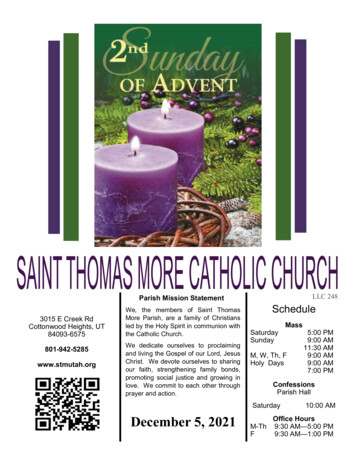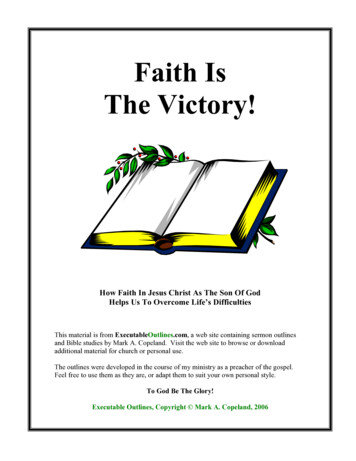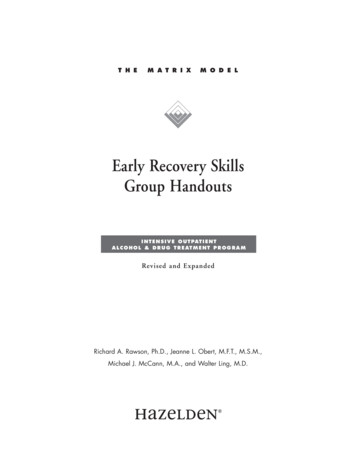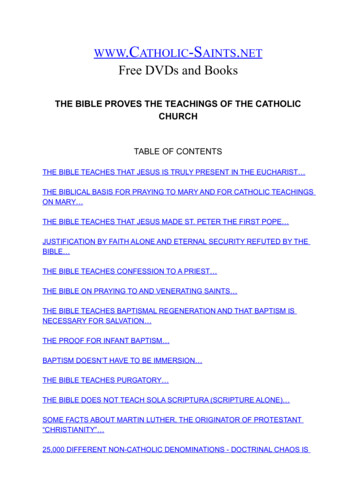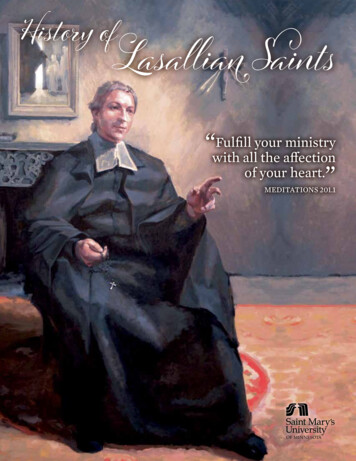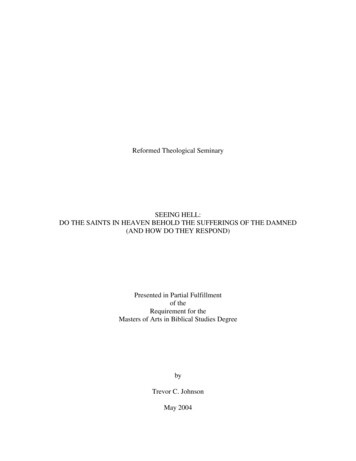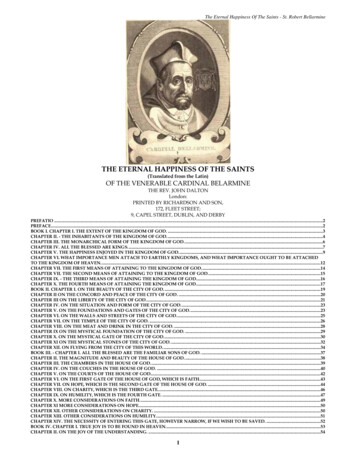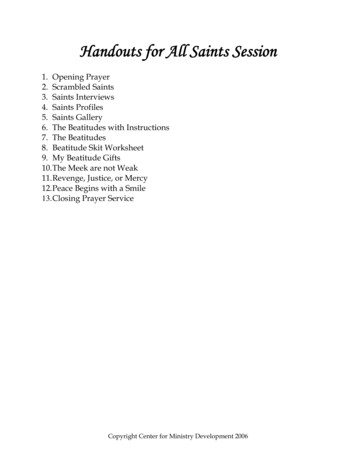
Transcription
Handouts for All Saints Session1. Opening Prayer2. Scrambled Saints3. Saints Interviews4. Saints Profiles5. Saints Gallery6. The Beatitudes with Instructions7. The Beatitudes8. Beatitude Skit Worksheet9. My Beatitude Gifts10. The Meek are not Weak11. Revenge, Justice, or Mercy12. Peace Begins with a Smile13. Closing Prayer ServiceCopyright Center for Ministry Development 2006
Opening Prayer ServiceOpening PrayerLeaderGod of holiness, we thank you for giving the saints the power of your grace so that they wereenabled to use their gifts in great ways. May their prayers encourage each of us to find our ownway of holiness. We pray this through Christ our Lord. Amen.Reading1 John 3:1a“See what love the Father has bestowed on us that we may be called the children of God.”The Word of the Lord.ReflectionLeaderChildren of God. That’s what we are. That’s what the saints are. Children of God who receivegreat gifts from the loving Father. I invite you to close your eyes for a moment and think about agift you once received from a loving parent in your life. (Pause) That parent could be yourmother or father, a grandparent, or someone else who is like a parent to you. Think of a veryspecial gift you received from that person.That gift is a sign of your parent’s love for you. Think about what you did with the gift after youreceived it. Did you use it all by yourself, or did you use it with other people? Did it bring youhappiness? Did it bring others happiness in some way? Usually the best gifts we receive help usto give to others in some way or another. If you haven’t yet used this gift for or with others insome way, think for a moment about how you might share this gift with someone.LitanyLeaderOur response to the litany will be, “Bless us, children of God.”LeaderHoly saints of God, we praise the Lord for the generous ways in which you have shared your giftswith the world, we pray AllBless us, children of God.LeaderHoly saints of God, we are thankful to the Church for telling us your stories for century aftercentury, we pray Copyright Center for Ministry Development 2006
AllBless us, children of God.LeaderHoly saints of God, pray for us as we seek to become holy by accepting God’s gift to us, we pray AllBless us, children of God.LeaderHoly saints of God, pray for us as we seek to become holy by using the gifts God has given to us,we pray AllBless us, children of God.LeaderHoly saints of God, pray for us so that the sharing of our gifts will increase faith, hope, and lovein the world, we pray AllBless us, children of God.Closing PrayerLeaderGod has given all of you a special gift, a spiritual gift, because you are a child of God. God lovesyou and gives you the greatest gifts. Let us pray that we will always use God’s great gifts toexpress our love for others. We ask this through Christ our Lord.AllAmenCopyright Center for Ministry Development 2006
Scrambled SaintsName of SaintDetail about OER18.TIANSUGI19.PPYALROCopyright Center for Ministry Development 2006
Saint InterviewsSt. Elizabeth Ann SetonSetting: A school classroom. Elizabeth is cleaning up at the end of the day.1. What’s your name?2. Where are you from?3. Where were you born? What year?4. What is special about you being born in New York City?5. Tell us a little bit about your family.6. Were you born Catholic?7. How did you become Catholic?8. I see you’re cleaning up after a day of work. Tell us about the work you do.9. What would you say is God’s special gift just for you?St. BenedictSetting: A chapel in a monastery. Benedict is on his way outside with a tool (rake,hoe, or shovel) in his hand.1. What’s your name?2. Where are you from?3. When were you born?4. What are times like here in the 6th century?5. I see your leaving your chapel with a gardening tool in your hand. What is thatall about?6. People say that you’re an expert at helping people get along in communities.Can you tell us a few of your secrets?7. I’ve heard that only men live here in your monastery. What is a woman to do ifshe wants to enjoy the fruits of your labor?8. What do people mean when they talk about “Benedictine hospitality?”9. What would you say is God’s special gift just for you?St. PaulSetting: St. Paul is sitting at a simple table writing a letter.1. What’s your name?2. Was that always your name?3. What were you like when you were Saul?4. Tell us about your conversion experience.5. What are gentiles?6. Why are they so important to you?7. I understand you are quite a traveler. Tell us about some of your journeys.8. What are you writing?9. What is so special about your letter writing?10. What would you say is God’s special gift just for you?Copyright Center for Ministry Development 2006
St. Teresa of AvilaSetting: Teresa is praying fervently in a simple chapel. It would be great if you couldmake it appear like she is levitating.1. What is your name?2. Where are you from?3. I understand that you used to enjoy the high life, even after you became a nun.Tell us about that.4. What happened? Why are you living in such simple conditions here?5. There are rumors flying around that you’re the flying nun. What’s that allabout?6. I understand you’re a great writer. How has your writing changed your life andthe life of the Church?7. What would you say is God’s special gift just for you?Copyright Center for Ministry Development 2006
Saints ProfilesThe following Saints Profiles are used throughout the All Saints activities. They are designed tobe used by leaders to share the story of the saints and as participant handouts (for olderchildren through adults). They are arranged in chronological order by feast day or anniversarydate. St. Elizabeth Ann Seton (January 4) St. John Bosco (January 31) St. Scholastica (February 10) andSt. Benedict (July 11) Blessed Katharine Drexel (March 3) Archbishop Oscar Romero (March 24) Sr. Thea Bowman (March 30) St. John Baptist de la Salle (April 7) Blessed Damien of Molokai (April 15) St. Joan of Arc (May 30) Pope John XXIII (June 3) St. Peter and St. Paul (June 29) St. Benedict (July 11) St. Ignatius of Loyola (July 31) The Proper of Saints in the Sacramentary hasprayers for the following saints who aredescribed in the Saints Profiles.The Lectionary contains the readings for thefollowing saints who are described in theSaints Profiles.January 4—St. Elizabeth Ann SetonJanuary 25—Conversion of St. PaulJanuary 31—St. John BoscoFebruary 10—St. ScholasticaApril 7—St. John Baptist de la SalleJune 29—Sts. Peter and PaulJuly 11—St. BenedictJuly 31—Ignatius of LoyolaAugust 11—St ClareAugust 14—St. Maximilian KolbeSeptember 27—St. Vincent de PaulOctober 4—St. Francis of AssisiOctober 15—Teresa of AvilaNovember 3—St. Martin de PorresNovember 13—St. Francis Xavier CabriniDecember 3—St. Francis XavierJanuary 25—Conversion of St. PaulJanuary 31—St. John BoscoFebruary 10—St. ScholasticaApril 7—St. John Baptist de la SalleJune 29—Sts. Peter and PaulJuly 11—St. BenedictJuly 31—Ignatius of LoyolaAugust 11—St ClareSeptember 27—St. Vincent de PaulOctober 4—St. Francis of AssisiOctober 15—Teresa of AvilaNovember 3—St. Martin de PorresDecember 3—St. Francis XavierSt Clare (August 11)St. Maximilian Kolbe (August 14)St. Hildegard of Bingen (September 17)St. Vincent de Paul (September 27)Mother Teresa of Calcutta (September 10)St. Francis of Assisi (October 4)St. Teresa of Avila (October 15)St. Martin de Porres (November 3)St. Francis Xavier Cabrini (November 13)Dorothy Day (November 29)St. Francis Xavier (December 3)Thomas Merton (December 10)Copyright Center for Ministry Development 2006
St. Elizabeth Ann Seton(1774-1821)Feast Day: January 4It is true the Journey is long, the burden is heavy—but the Lord delivers his faithful servantsfrom all their troubles Is it nothing to sleep serene under his guardian wing—to take to thebrightness of the glorious sun with renewed strength and renewed blessings to be assuredthat love is enough to tie us faithfully to him.(Elizabeth Ann Seton)All her life, Elizabeth Ann Seton loved to conquer challenges. In a way, that was true even afterher death. She is the first person to be declared a saint who was born in what would soonbecome the United States of America.Elizabeth was born in New York City. Her parents were wealthy and well-educatedEpiscopalians. They believed in helping the poor, and they taught her to do so from the timeshe was a small child. She later married a successful businessman and they began a family.Elizabeth still found time to do important volunteer work. She founded the Society for theRelief of Poor Widows with Small Children.By the time Elizabeth was 30 years old, her situation had changed completely. Her husband losthis business, grew seriously ill and died. Now she herself was a widow with young children.During her husband’s illness, encouragement from Catholic friends had consoled her. Shedecided to become a Catholic, although in doing so she lost the support of her wealthy family.As a single parent with five children to care for, she had no way to earn a living.However, soon she was invited to begin a school for young girls from poor families. The schoolshe founded, near Baltimore, Maryland, was the first Catholic school in the United States. With18 other dedicated women, Elizabeth went on to organize the first group of women religious inthe United States, the Sisters of Charity.Cheerfully, she started from scratch in the work of building Catholic education. That meant notonly starting more schools but also training teachers and writing textbooks herself.Elizabeth Ann Seton accomplished all this in a very short life. She died when she was in her late40s. The Catholic school system that she founded now thrives all over North America.SourceCompanion to the Calendar. Mary Ellen Hynes. (Chicago: Liturgy Training Publications, 1993).Copyright Center for Ministry Development 2006
St. John Bosco(1815-1888)Feast Day: January 31To call others to Christ, John Bosco used everything he could think of, even acrobatic tricks andtightrope walking. His cleverness stood him in good stead. Many young people learned aboutGod because of the care they received from John.He was born in a small village in the Piedmont region of Italy. His father, a peasant farmer, diedwhen John was only two years old, leaving the family very poor. When young John went awayto the seminary at age 18, even the clothes on his back had been donated by people from hisvillage.John decided that his ministry would be in Turin, the closest city to his village. Turin wasbecoming an industrial town. Teenage boys would leave their poor families in the countrysideand come into town searching for work. In the city these teenagers lived in terrible conditions.Even before his ordination, John began taking a group of boys out to the country every Sundayfor sports, a picnic, song and prayer. No one else cared about them. After John became a priesthe housed boys who had nowhere else to live. Then he began programs to train them asshoemakers, tailors and printers. The training protected them from a harsh world they were tooyoung to face.Many of the boys and young men John assisted were troubled. Often they had experiencedabuse or neglect. Somehow John called forth the best in them by affirming them and treatingthem kindly. This was considered a very unusual approach to teaching. Most teachers in thosedays thought that children must be forced to learn and punished severely when they didn’t.The number of young people in John’s care grew ever larger. He had trouble finding assistantswho understood his gentle teaching methods. Eventually he began an order of priests and anorder of sisters, the Salesian order. He also started a group of laypeople called Cooperators. Allwere trained especially for this work. Today these orders serve in schools, colleges, seminaries,hospitals and missions all over the world.SourceCompanion to the Calendar. Mary Ellen Hynes. (Chicago: Liturgy Training Publications, 1993).Copyright Center for Ministry Development 2006
St. Scholastica and St. Benedict(480-550)Feast Day: St. Scholastic—February 10, St. Benedict—July 11All guests who present themselves are to be welcomed as Christ, for he himself will say:“I was a stranger and you welcomed me (Matthew 25:35). Proper honor must be shownto all, especially to those who are our faith (Galatians 6:10) and to pilgrims. Great careand concern are to be shown in receiving poor people and pilgrims, because in them moreparticularly Christ is received Then as we progress in this way of life and in faith, we shall run on the path of God’scommandments, our hearts overflowing with inexpressible delight of love. Neverswerving from his instructions ., but faithfully observing his teaching until death, weshall through patience share in the suffering of Christ that we may deserve also to sharein his kingdom.(Benedict)Fifteen hundred years ago in Italy, the old Roman government was in chaos. The army brokeranks. The police stopped functioning. There was no one to protect people from bandits. Eventhe roads fell into disrepair, and markets quickly ran out of food. What little food was left in theland was hoarded by the strong. Weak and sick people starved. This kind of selfishness turnedneighbors against neighbors and destroyed families.In these terrible times, a man named Benedict organized a community of men. His sisterScholastica did the same thing for women. Benedict put together a “Rule of Life,” a verysensible set of guidelines for helping people get along and work together effectively. Aroundthe year 530, Benedict founded a monastery called Monte Cassino. Everyone in the communitylived under one roof. The “Rule of Life” divided the day into times of prayer, study, work andrest. Scholastica settled nearby and formed the first community of women to use Benedict’srule.The Rule said that greed, grudges, pride, and laziness have no place in a community. Instead,everyone needs to work hard for the sake of one another. Generosity, forgiveness and charityare the only ways to bring order out of chaos. Daily life was organized according to a Latinmotto, ora et labora, “prayer and work.” Benedict taught people a way to use prayer andChristlike attitudes to get over their fear and mistrust of each other.In these communities, everyone worked and no one kept personal possessions. This helped toprevent envy and pride. Benedict encouraged a spirit of generous forgiveness. This generositywas extended to strangers and the needy. Every visitor to the abbey was treated like Christ. Noone was ever turned away. Hospitality is still a trademark of Benedictine communities aroundthe world.Copyright Center for Ministry Development 2006
The Benedictines soon numbered hundreds of houses throughout Europe. They did not startout with the intention of preserving and passing on culture, but that is what they did. Inestablishing their houses, they began to clear forests, reclaim land, and give some system toagriculture. In so doing, they were laying the foundations for economic recovery and stability.In addition, the monks began the process of copying manuscripts so that nothing of the gloriouspast was lost. The copying of manuscripts grew into a large monastic industry. Muchknowledge of the ancient world has survived only through the efforts of these monk copyists.In the natural course of events, the Benedictine monasteries eventually became the inns andhospitals of the time, because they were often the only havens of peace and security in a worldof upheaval and war.Benedict spent his life leading his monks, counseling visitors to the abbey and caring for thesick who lived nearby. Benedictine monks and nuns would later be given credit for preservingEuropean civilization during the Middle Ages. Because of this, Benedict and Scholastic havebeen named patron saints of Europe.SourceCompanion to the Calendar. Mary Ellen Hynes. (Chicago: Liturgy Training Publications, 1993).Take Me Home Too. Peter Mazar. (Chicago: Liturgy Training Publications, 1997).Copyright Center for Ministry Development 2006
Saint Katharine Drexel(1858-1955)Feast Day: March 3Resolve: Generously and with no half-hearted, timorous dread of opinions of the Church and men tomanifest my mission .You have no time to occupy your thoughts with that complacency orconsideration of what others will think. Your business is simply, “What will my Father in heaven think?”(Katherine Drexel)Katharine Drexel was from a wealthy and well-known Philadelphia family. Her parents weregood to the poor. Her father made large donations to charity and her mother helped poorfamilies to pay their rent every month. As a child, Katharine reflected on this. She wanted tohelp the poor when she grew up but wasn’t sure how to do so.Katharine and her family traveled all over the United States and Europe. On one unforgettabletrip, the Drexels traveled to the state of Washington on a private train. Katharine was shockedby the poverty she saw on Indian reservations there. Later, while visiting Rome, the familyspoke with Pope Leo XIII. Katharine begged him to send missionaries to help neglected NativeAmerican communities like the ones she had seen. To her shock, he said, “My child, why don’tyou become a missionary yourself?”Eventually Katharine Drexel did just that. Then, as always, talented and committed workerswere more urgently needed than donations. In 1891, with 13 other women, she founded theSisters of the Blessed Sacrament. They worked to provide for the needy, and over timeKatharine donated 12 million dollars of the fortune she had inherited.Katharine and her sisters first opened a boarding school for Pueblo Indian students in Santa Fe,New Mexico. In time they founded missions for Indians in 16 states. They began a secondaryschool for African American students in New Orleans. This school was the forerunner of XavierUniversity. (Other universities in the South were not open to black students in those daysbecause of segregation laws.)In the years after the First World War, when African American people moved from the South towork in northern cities, the sisters also started schools in Chicago, Boston and New York City.It would not have been easy to recognize Reverend Mother Katharine as the same person whohad once toured the West on a private train. As she traveled across the country spending herfortune on new schools, she tried to live as simply as she could. Her clothing was threadbare.She bought the least expensive railroad tickets and carried her lunch in a brown paper bag.Katharine Drexel died in 1955 at the age of 96. People of all races from across the United Statesjourneyed to Philadelphia to attend her funeral.SourceCompanion to the Calendar. Mary Ellen Hynes. (Chicago: Liturgy Training Publications, 1993).Copyright Center for Ministry Development 2006
Sister Thea Bowman(1937-1990)March 30—Anniversary of the Death of Thea BowmanMaybe I’m not making big changes in the world, but if I have somehow helped orencouraged somebody along the journey then I’ve done what I’m called to do.(Thea Bowman)Thea Bowman was one of the great treasures of the American Catholic church. As a FranciscanSister, she managed, in her manifold witness to the gospel, to integrate the resources of herCatholic faith with her identity as an African-American woman. Ablaze with the spirit of love,the memory of struggle, and a faith in God’s promises, she impressed her many audiences notjust with her message but with her nobility of spirit. No one she encountered, whether schoolchildren, college students, cynical journalists, or a convention hall of bishops, could fail to catcha measure of her joy and gratitude for the gift of life. She was a particular inspiration to theblack Catholic community, helping them to assert their pride of place among the People of God,while also encouraging them to enrich the wider church with the gifts of their distinctiveculture and spirituality.She was born Bertha Bowman in rural Mississippi in 1937. While attending a parochial schoolshe was baptized as a Catholic at the age of ten. The most formative experience of her childhoodcame when her parents switched her to a new school run by the Franciscan Sisters of PerpetualAdoration. There she found her love of learning but also her vocation to become a nun. To herfamily and friends it was an astonishing decision. Nevertheless, she entered the convent whenshe was sixteen and took the name Sister Thea (“of God”).As the only black person in a white religious order she tended to stand out. But whatever theexpectations of her community, she had no desire to “blend in.” She brought with her a strongsense of her identity as a black Catholic woman, and over time she came to believe that thisidentity entailed a very special vocation. She was committed to asserting a black way of beingCatholic. Previously black Catholics were expected to conform to the spirituality of the whiteEuro-American church. The gospel hymns, the spirituals, the dancing, the testifying in thespirit—all features of the Protestant black churches—were foreign in the Catholic church. Butfor black Catholics, Sister Thea believed, this accounted for a sense of cultural marginality. Notonly should there be room in the Catholic church for the spiritual traditions of AfricanAmericans, but their experience had much to contribute to the wider church. Part of thisexperience was the history of slavery and oppression. But part of it also was a spirituality ofsurvival and resistance reflected in the tradition of the spirituals, the importance of family,community, celebration, and remembrance.“What does it mean to be black and Catholic?” she asked. “It means that I come to my churchfully functioning. I bring myself, my black self, all that I am, all that I have, all that I hope toCopyright Center for Ministry Development 2006
become. I bring my whole history, my traditions, my experience, my culture, my AfricanAmerican song and dance and gesture and movement and teaching and preaching and healingand responsibility as gift to the Church.”After earning a doctorate in English, Thea returned to the South to work with the church inMississippi and Louisiana. In 1980 she helped to found the Institute of Black Catholic Studies atXavier University in New Orleans. This became the base for her ministry as a speaker andevangelist. Thea was an extraordinary, spellbinding speaker. A combination storyteller,preacher, and performer, she brought to her lectures the atmosphere of a revival meeting.Punctuating her speaking with renditions of the spirituals, she generally had her audiences,black or white, singing along with her before she was finished.She was invited to speak before hundreds of groups, including the U.S. Catholic bishops at theirannual meeting in 1989. In one speech she noted that women were not allowed to preach in theCatholic church. But this shouldn’t stop them from preaching everywhere else! “God has calledus to speak the word that is Christ, that is truth, that is salvation. And if we speak that word inlove and faith, with patience and prayer and perseverance, it will take root. It does have powerto save us. Call one another! Testify! Teach! Act on the Word! Witness!”By this time Sister Thea was compelled to bear witness in a different way. She was diagnosed in1984 as suffering from breast cancer. Though increasingly ill, Thea continued her extensivetravels and speaking, even when she was confined to a wheelchair. With her bright Africanrobes and her now-bald head, she was, as always, a striking figure. But now when she sang thespirituals—“Sometimes I feel like a motherless child / A long way from home”—her audiencedetected an even more personal and poignant confession of faith.The faith that had sustained the slaves, the hope expressed in the spirituals, the love embodiedby St. Francis, now sustained her in her personal way of the cross. And to her other mighty giftsto the church she now added the witness of her courage and trust in God:When I first found out I had cancer, I didn’t know what to pray for. I didn’t know if I should prayfor healing or life or death. Then I found peace in praying for what my folks call “God’s perfectwill.” As it evolved, my prayer has become, “Lord, let me live until I die. By that I mean I want tolive, love, and serve fully until death comes. If that prayer is answered how long really doesn’tmatter. Whether it’s just a few months or a few years is really immaterial.Asked how she made sense out of her suffering, she answered, “I don’t make sense of suffering.I try to make sense of life I try each day to see God’s will I console myself with the oldNegro spiritual: ‘Sooner will be done the troubles of this world. I’m going home to live withGod.’”Sister Thea died on March 30, 1990, at the age of fifty-three.SourceAll Saints—Daily Reflections on Saints, Prophets, and Witnesses for Our Time. Robert Ellsberg. (NewYork: Crossroad Publishing, 1997).Copyright Center for Ministry Development 2006
Oscar Arnulfo Romero(1917-1980)March 24—Anniversary of the Death of Archbishop Oscar RomeroI rejoice, brothers and sisters, that our church is persecuted precisely for its preferential option for thepoor and for seeking to become incarnate in the interests of the poor Whoever out of love for Christgives himself to the service of others will live, like the grain of wheat that falls and only apparentlydies. If it did not die it would remain alone .Only in undoing itself does it produce the harvest.(Oscar Romero)Oscar Romero was born in a small town in a remote part of El Salvador, which is a tiny countryin Central America. Oscar’s family was neither rich nor poor. This was unusual in El Salvador,where there was almost no middle-income people. A few rich, powerful people rule the manypoor.Oscar was apprenticed to a carpenter at age 13, but he wanted to be a priest, so a year later heentered the seminary. Oscar was bright, and he was placed in church jobs that would train himto become a bishop. When he was appointed archbishop of San Salvador, he was welcomed bythe rich ruling families of the country. Although they were guilty of violence against the poor,they thought Oscar would not make any trouble for them. He was known to be shy andconservative.But after a short time as bishop, Oscar could no longer overlook the sufferings of the poor. Hesaid, “They are crushed in their homes, taken prisoner, made to disappear. They go to jail, arejudged falsely, and no one pays any attention.”He felt called to be the voice of all the people without a voice. During his sermons in church hespoke against political repression. These sermons were broadcast on radio and thousands ofpeople listened. “Be a patriot; kill a priest.” In the troubled Latin American country of ElSalvador, handbills bearing this violent slogan were once seen everywhere. In spite of thedanger, Archbishop Oscar Romero kept speaking out for justice. His boldness eventually costhim his life.Some Salvadoran priests and other church workers were being called traitors for defending therights of the poor. Some had already been murdered. After three years of constant threats to hislife, Oscar was shot to death while celebrating Mass at a hospital chapel. His assassinationshocked the world.The violence in El Salvador was only beginning. Bomb blasts and rifle shots exploded into thehuge crowds attending his funeral, killing 40 more people. During the 1980s, many thousandsdied violently. The people of El Salvador know that their bishop died for the sake of his flock.To this day, they treasure his memory.SourceCompanion to the Calendar. Mary Ellen Hynes. (Chicago: Liturgy Training Publications, 1993).Copyright Center for Ministry Development 2006
St. John Baptist de La Salle(1651-1719)Feast Day: April 7Since you are ambassadors and ministers of Jesus Christ in the work that you do, youmust act as representing Jesus Christ himself. He wants your disciples to see him in youand receive your teaching as if he were teaching them. They must be convinced that thetruth of Jesus Christ comes from your mouth, that it is only in his name that you teach,that he has given you authority over them.Have you .charity and tenderness towards the poor children whom you have toinstruct? Do you avail yourself of the affection the children have for you to attract themto God? If you show the firmness of a faith in withdrawing them from evil, you shouldalso show the tenderness of a mother in gathering them together, and in doing them allthe good in your power.(John Baptist de La Salle)In the days of King Louis XIV of France, the country had only two classes of people; the verypoor and the very rich. In time, these unjust conditions would lead to the French Revolution.But John Baptist de la Salle did something revolutionary of his own. Born to a rich and wellknown family, he spent his life teaching the poor.John was born in the city of Rheims. As a youth he was intelligent, handsome and a smoothtalker. He became a priest and studied to receive a doctorate in theology. With so mucheducation, he expected to hold a powerful position in the church.John’s ambitions took an unexpected turn in Rheims. There he met Adrian Nyel. In those days,only the rich could afford to send their children to school. Adrian had a dream of educatingpoor children, and he wanted John to help him. John did not enjoy going into the slums, butAdrian convinced him to help begin a school for poor boys. John began training teachers. Hetaught them how to plan lessons and keep order in classrooms.Soon his community of teachers became the “Brothers of the Christian Schools.” They were thefirst religious group whose special mission was to teach the poor. The brothers taught theirstudents how to live i
Saints Profiles The following Saints Profiles are used throughout the All Saints activities. They are designed to be used by leaders to share the story of the saints and as participant handouts (for older children through adults). They are arranged in chronological order by feast day o


